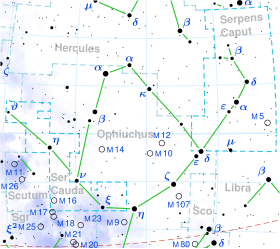Nu Serpentis
| Observation data Epoch J2000 Equinox J2000 | |
|---|---|
| Constellation | Serpens |
| Right ascension | 17h 20m 49.66149s[1] |
| Declination | −12° 50′ 48.7533″[1] |
| Apparent magnitude (V) | 4.32[2] |
| Characteristics | |
| Spectral type | A2V[3] |
| U−B color index | +0.04[4] |
| B−V color index | +0.03[4] |
| Astrometry | |
| Radial velocity (Rv) | +4.80[5] km/s |
| Proper motion ( | RA: +43.40[1] mas/yr Dec.: +2.61[1] mas/yr |
| Parallax ( | 16.05 ± 0.26 mas[1] |
| Distance | 203 ± 3 ly (62 ± 1 pc) |
| Absolute magnitude (MV) | 0.35[2] |
| Details | |
| Mass | 2.64[6] M☉ |
| Radius | 3.0[7] R☉ |
| Luminosity | 76[6] L☉ |
| Surface gravity (log g) | 3.95[8] cgs |
| Temperature | 9,120[6] K |
| Metallicity [Fe/H] | 0.00[9] dex |
| Rotational velocity (v sin i) | 123[6] km/s |
| Age | 350[10] Myr |
| Other designations | |
| Database references | |
| SIMBAD | data |
This is an A-type main-sequence star with a stellar classification of A2V,[3] and is generating energy through hydrogen fusion at its core. It is 350[10] million years old with a high rate of spin, showing a projected rotational velocity of 123 km/s.[6] The star has 2.64[6] times the mass of the Sun and 3.0[7] times the Sun's radius. It is radiating 76 times the Sun's luminosity from its photosphere at an effective temperature of 9,120 K.[6] Nu Serpentis has an optical companion, a magnitude +9.4 star at an angular separation of 46 arcseconds.[12]
References
[edit]- ^ a b c d e f Van Leeuwen, F. (2007). "Validation of the new Hipparcos reduction". Astronomy and Astrophysics. 474 (2): 653–664. arXiv:0708.1752. Bibcode:2007A&A...474..653V. doi:10.1051/0004-6361:20078357. S2CID 18759600. Vizier catalog entry
- ^ a b c Anderson, E.; Francis, Ch. (2012). "XHIP: An extended hipparcos compilation". Astronomy Letters. 38 (5): 331. arXiv:1108.4971. Bibcode:2012AstL...38..331A. doi:10.1134/S1063773712050015. S2CID 119257644. Vizier catalog entry
- ^ a b Abt, Helmut A.; Morrell, Nidia I. (1995). "The Relation between Rotational Velocities and Spectral Peculiarities among A-Type Stars". Astrophysical Journal Supplement. 99: 135. Bibcode:1995ApJS...99..135A. doi:10.1086/192182.
- ^ a b Mallama, A. (2014). "Sloan Magnitudes for the Brightest Stars". The Journal of the American Association of Variable Star Observers. 42 (2): 443. Bibcode:2014JAVSO..42..443M.Vizier catalog entry
- ^ a b Wilson, R. E. (1953). "General Catalogue of Stellar Radial Velocities". Carnegie Institute Washington D.C. Publication. Carnegie Institution for Science. Bibcode:1953GCRV..C......0W. ISBN 9780598216885. LCCN 54001336.
- ^ a b c d e f g Zorec, J.; Royer, F. (2012). "Rotational velocities of A-type stars". Astronomy & Astrophysics. 537: A120. arXiv:1201.2052. Bibcode:2012A&A...537A.120Z. doi:10.1051/0004-6361/201117691. S2CID 55586789. Vizier catalog entry
- ^ a b Allende Prieto, C.; Lambert, D. L. (1999). "Fundamental parameters of nearby stars from the comparison with evolutionary calculations: Masses, radii and effective temperatures". Astronomy and Astrophysics. 352: 555–562. arXiv:astro-ph/9911002. Bibcode:1999A&A...352..555A. Vizier catalog entry
- ^ David, Trevor J.; Hillenbrand, Lynne A. (2015). "The Ages of Early-Type Stars: Strömgren Photometric Methods Calibrated, Validated, Tested, and Applied to Hosts and Prospective Hosts of Directly Imaged Exoplanets". The Astrophysical Journal. 804 (2): 146. arXiv:1501.03154. Bibcode:2015ApJ...804..146D. doi:10.1088/0004-637X/804/2/146. S2CID 33401607. Vizier catalog entry
- ^ Gontcharov, G. A. (2012). "Dependence of kinematics on the age of stars in the solar neighborhood". Astronomy Letters. 38 (12): 771–782. arXiv:1606.08814. Bibcode:2012AstL...38..771G. doi:10.1134/S1063773712120031. S2CID 118345778. Vizier catalog entry
- ^ a b c De Rosa, R. J.; et al. (2013). "The VAST Survey - III. The multiplicity of A-type stars within 75 pc". Monthly Notices of the Royal Astronomical Society. 437 (2): 1216. arXiv:1311.7141. Bibcode:2014MNRAS.437.1216D. doi:10.1093/mnras/stt1932. S2CID 88503488.
- ^ "nu Ser". SIMBAD. Centre de données astronomiques de Strasbourg. Retrieved 2019-10-04.
- ^ Mason, Brian D.; Wycoff, Gary L.; Hartkopf, William I.; Douglass, Geoffrey G.; Worley, Charles E. (2001). "The 2001 US Naval Observatory Double Star CD-ROM. I. The Washington Double Star Catalog". The Astronomical Journal. 122 (6): 3466. Bibcode:2001AJ....122.3466M. doi:10.1086/323920. Vizier catalog entry
External links
[edit]- Kaler, James B. (July 19, 2013), "Nu Serpentis", Stars, University of Illinois, retrieved 2017-03-31.

